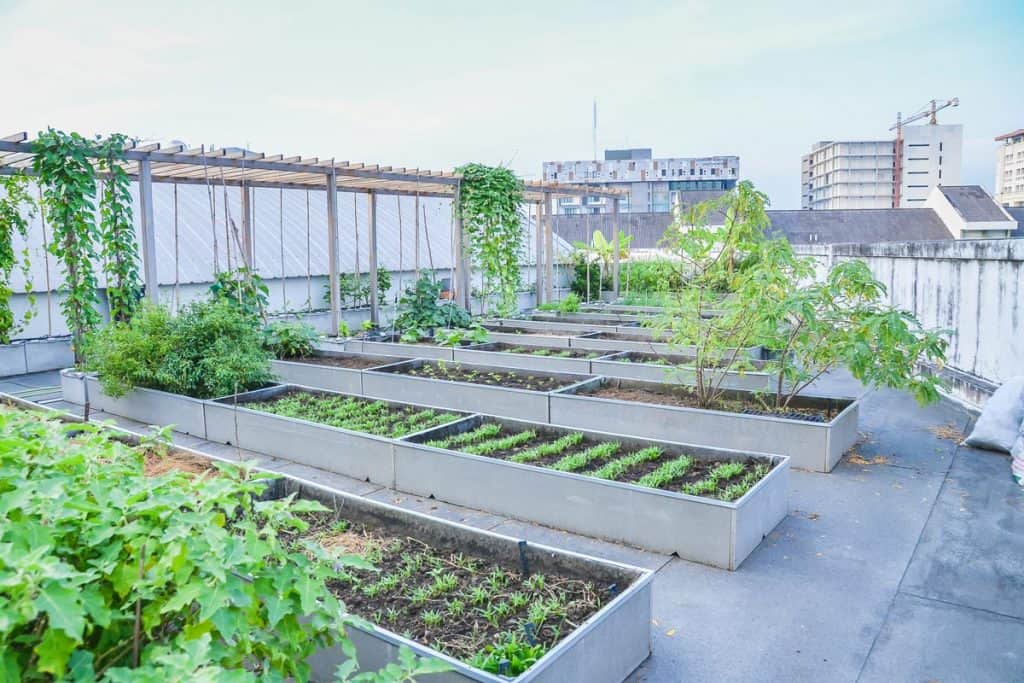Growing your food can be an appealing way to reduce costs and ensure the quality of the food you eat. If you live in an apartment building, a condominium complex, or another type of urban housing, you may believe that you do not have this option. However, rooftop vegetable gardens could be the solution you seek. But how do you make a rooftop vegetable garden? We've done the research to help you learn the steps you need to take to create a rooftop vegetable garden.

Even if you do not have much experience with gardening or vegetables, creating a rooftop vegetable garden is a pretty straightforward process.
- First, confirm with your building manager, HOA, or other organization that a rooftop garden is allowed.
- Determine whether the roof of your building can handle the additional weight of a garden. You may want to discuss this with an engineer or an architect if your building manager or super does not know.
- Make sure you have consistent access to the roof.
- Decide whether you want to build a raised bed or want to focus on container gardening.
- Find a spot on the roof that receives ample sunlight.
- Try to find a spot that is not subject to a significant amount of wind. If there is no existing buffer from the wind, consider building a windbreak.
- Utilize the right type of soil -- potting soil works best for a rooftop garden.
- Make sure that you have a plan for watering your vegetables and try to find a storage area to save time and energy carrying supplies up and down from the roof.
By following these steps, you can get your rooftop vegetable garden set up very quickly.
Now that you know the critical steps for creating your rooftop garden keep reading to find out more information about each of these steps as well as to discover the answers to additional questions related to rooftop vegetable gardens.
Bringing Your Rooftop Vegetable Garden To Life
Check for Building Restrictions
When you decide you are ready to create your rooftop vegetable garden, be sure to speak to the people in charge of your building. You'll need to ensure that there are no regulations or rules in place that outlaw rooftop gardens. It would be a shame to overlook this step and have all of your time, energy, and money essentially wasted.
Determine if the roof can Hold the Weight
While researching these rules and regulations, be sure to discuss the roof specifications for your building either with the super, an architect, or an engineer. You'll want to make sure that your building's roof can handle the additional weight from your garden. Though it may not seem like a significant amount, vegetables, soil, and containers will add load to the roof, and you would not want to risk issues to your building.
Confirm Access
The third and final fact-finding step is to confirm that you have consistent access to the roof. Finding out if your building forbids tenets from accessing the roof or if you need a key to get out or back in are important facts. If you cannot care for, cultivate, and harvest your vegetables, your garden won't last very long.
Choose Between Raised Beds or Containers
Once you have confirmed permission, structural integrity, and access, you can get started. Decide whether you want to utilize containers or if you want to build raised beds (weight limitations may make the decision for you). Container gardening uses pots to grow your vegetables. Certain vegetables do better in these conditions, so choosing your method will determine what you can and should grow.
Choose a Spot
Then, you'll want to find a spot on the roof that gives you ample sunlight each day. You'll need at least six hours of sun for most plants. If possible, you should find a spot with reduced wind exposure. The higher your building, the more wind to which your plants will be exposed. If you cannot find a spot like this, you will need to utilize a windbreak -- either something you make or something like lattice you buy and put up to shelter the plants.
Use Potting Soil
Finally, be sure that you are using the right type of soil. Though you might think gardening soil would be best, potting soil will be most beneficial. It is lighter and will hold water more effectively than gardening soil. And, watering will likely be your biggest issue when it comes to your rooftop garden. So, you will want to do everything possible to make watering as easy as possible. The right type of soil will do that as will formulating the right watering strategy for your garden.
What Vegetables Are Best For A Rooftop Garden?

Now that we know how to set up a rooftop vegetable garden, what are the best vegetables for your garden? There are a whole host of vegetables and fruits that do well in containers and that will thrive in the high sunlight conditions on a rooftop. Leafy greens like kale and spinach excel in containers. Cherry tomatoes, blueberries, strawberries, cucumbers, eggplant, and string beans are all options for your rooftop vegetable garden, too. If you are planting tomatoes or cucumbers, be sure to include fertilizer when initially planting.
For more ideas about potential plants for your rooftop vegetable garden, check out our blog post titled 17 Best Plants For A Roof Garden. This post has some great information about plants that you can grow with relative ease.
How Do You Water A Rooftop Vegetable Garden?
Keeping your plants well-tended includes proper watering. While it would be fantastic if you could count on rain to take care of watering your vegetables, the reality is that it does not rain consistently enough to keep your veggies from dying of thirst. So, you'll need a plan to ensure that you keep your garden well watered. But how can you do this?
The most obvious answer (aside from the rain, of course) is a watering can. However, lugging a heavy watering can up to the roof without spilling it everywhere is problematic. Even if you can carry two watering cans at the same time, it is exceedingly likely that you will have to make multiple trips. This can be tiring and become aggravating over time.
So, what are your other options? One solution could be to install a rain collecting basin. As you did with the garden, you'll need to confirm that the roof can handle the additional weight that would result from water being stored on the roof.
You may also be able to attach a hose to a faucet on the roof. If there is not a faucet on the roof already, you may be able to get your super to add one for you. This simple and relatively cheap option may be the easiest and most practical choice.
Another potential solution would be to install an automatic watering system. With approval from the proper authorities, you can connect your watering system to the building's plumbing and water your plants that way. You'll likely need to work with your building manager to devise a system to ensure that you are paying for your fair share of water. If you can utilize an automatic watering system, you will save yourself a significant amount of time and effort while ensuring that your vegetable garden thrives.
How Much Does A Rooftop Vegetable Garden Cost To Setup And Maintain?

There is probably one big question that remains on your mind: how much does all of this cost. This question is a bit relative. Much depends on the decisions each individual makes. Will you be utilizing a raised bed garden or a container garden? How many vegetables will you be trying to grow? Will you need to budget for a windbreak system? How often, based on where you live, will you need to water your vegetables? There are many variables associated with the cost of a rooftop garden.
For the sake of this blog, we will assume nearly perfect conditions. On average, you can likely expect to spend between $50 and $100 for seeds and plants, between $20 and $50 for a hose, anywhere from $50 to $100 for soil, and $100 to $200 for containers. If you need materials for a windbreak, you may expect to spend an additional $50 to $100. You will also need to factor in the cost of watering the plants. So, you can likely expect to spend around $500 to set up your garden and then at least another $20 per month to water it.
Summary
A rooftop vegetable garden is more than just a great hobby. It can be a way to reduce costs and provide organic food to your family. This post was written to help give you a more complete understanding of what it takes to create and maintain a rooftop vegetable garden. If you are interested in learning more about vegetable gardening options, check out some of our other blog posts like:
What Vegetables Can I Grow In Pots?
11 Edible Plants That Grow Fast
Happy growing!
